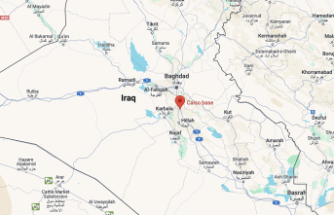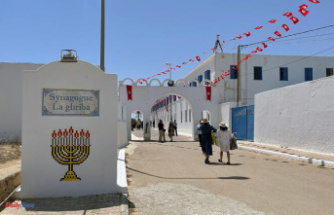When the reasons for the fall of the Roman Empire are discussed in the West, the word about the invasion of the Huns quickly comes up. These cavalry nomads from Central Asia appeared around 375 in the southern Ukrainian steppe and put an end to the ruling structures of the Goths and other peoples. Some submitted. Others crossed the Danube to find a new home in the Empire. The decisive date was August 9, 378. Emperor Valens (born 328) lost his army and life near Adrianople in an attempt to push back the Goths.
In contrast to many emperors of late antiquity, Valens did not pursue his uprising. Born into an officer's family from Pannonia, he had early obtained a post in the Imperial Guard, where his older brother Valentinian also served. His promotion to commander of the palace guard may also have had a positive effect on Valens' career. When Emperor Iovian died in 364 after a short term in office, high officials and officers agreed on Valentinian as his successor.
However, the army demanded that he take a counterpart in order to be able to cope with the numerous challenges at the borders. Valentinian summoned his younger brother and assigned him the east of the empire, while he himself took on the defense of the west. The decision may be a sign of which front was deemed to be more at risk from barbarian attacks.
Most sources portray Valens as "an average Kaiser, a hard-working soldier who did his best in a post he never aspired to, to further the interests of the empire and the people of the empire," writes his biographer Malcolm Errington. Revolutionary innovations or philosophical or theological decisions were not to be expected from him. "Order, uniformity and security" were the guiding principles of his policy.
Valens, therefore, having successfully put down a usurpation, took up quarters in Antioch. From here he was better able to react to the advances of the Sasanian Empire of New Persia, which opened a small war for Armenia. The emperor left the management of the Danube border to his officials in Constantinople.
They were obviously overwhelmed by the situation that presented itself to them from 375 onwards. Several Gothic and Alanian groups of warriors asked to be accepted into the empire, where they had previously been welcome as mercenaries. One association was also granted settlement in Thrace, but this was denied to others. Therefore, Goths and Alans took their destiny into their own hands, crossed the Danube and plundered through the country. They benefited from the fact that they could continue to dispose of their weapons and their own military organization. Rome's regional commanders still underestimated the danger and lost several battles with their weak border troops.
Eventually Valens felt compelled to look after things himself and moved north with the imperial army. At the same time he had asked for support from his nephew Gratian, who had succeeded Valentinian in the West in 375 after the death of Valentinian. But before he arrived with his troops, Valens decided to strike, perhaps because he wanted to "catch a notable success with his brother's youthful son, whose glorious deeds consumed him," speculated the Roman historian Ammianus Marcellinus, who as a senior officer and contemporary witness wrote the authoritative report on the events. Gratian had previously celebrated a great victory over the Alamanni on the Upper Rhine.
Indeed, Valens' chances were not bad. He had about 30,000 men with him, including numerous veterans and officers, as well as the Guards troops. Reconnaissance officers reported that the enemy army numbered only 10,000 men, but overlooked the fact that their strong cavalry had set out for a flanking operation, just as the Romans probably had no idea that the Goths were significantly more powerful than earlier immigrants from the north . Expecting an easy victory, Valens ordered the attack on August 9, 378.
Without having eaten their breakfast, the Roman troops in full battle gear marched against the enemy. The baggage train had been left behind at Adrianople. "The path led over mountainous terrain, the blazing hot sun was already up at noon when the enemy wagons were finally sighted at around eight o'clock," reports Ammianus.
The Goths had entrenched themselves with their families in a wagon complex on slightly elevated terrain. Whether he was impressed by the Roman superiority or simply wanted to gain time, the Goth leader Fritiger offered to negotiate and Valens agreed. But before the Roman delegation was ready to leave, the Guards on the right wing began to attack. Perhaps it was hunger that drove her to this lack of discipline.
But that started a chain reaction. Although the Roman formations were not yet drawn up in battle formation, individual units from the center and the cavalry on the left wing stormed aimlessly against the wagon fort. Their defenders were able to fend off the uncoordinated attacks. Before the Romans could regroup, Gothic and Alanian cavalry appeared to the west and "burst like lightning."
While individual formations on the left wing were still advancing, others hastily retreated. After forcing the Roman cavalry to retreat, Fritiger's horsemen charged the Roman infantrymen in the rear. The Roman reserve, which had formed the rear guard, made off in good time. "The infantry now stood uncovered, and their detachments were so densely packed that scarcely a man could draw his sword or withdraw his hand... All around them they saw every avenue of escape barred."
The Roman battle line soon broke up in a hand-to-hand skirmish. “Eventually everything turned dark red with blood, and wherever you looked, the fallen lay piled up in mountains, and you had to tread on the corpses ruthlessly,” writes Ammianus. Valens is said to have been fatally hit by an arrow, "but his body was nowhere to be found later". Two-thirds of the Roman army fell with him, including many experienced officers.
The resemblance to Cannae's battle description is striking. At the place in Apulia, the Carthaginian Hannibal had in August 216 BC. BC two Roman armies, 80,000 legionnaires, destroyed. Ammianus compared the defeat of Adrianople with this catastrophe and thus called for a new beginning: Just as the Roman Republic triumphed over Hannibal through a joint effort, the empire would also succeed if it finally broke away from the corrupt flatterers and incompetent commanders would separate.
Adrianople did mark a turning point, but in a different way than historians have imagined. The Romans managed to stabilize the situation. But unlike Cannae almost 600 years earlier, the empire lacked the soldiers for the great counterattack. Instead, the emperors had no choice but to take into service the powerful warrior groups, who had often enough received their training in the Roman army, together with their leaders. In return, they received land and gifts.
From then on, more and more barbarian groups forced their settlement on imperial soil, following the model of Fritiger's Gothic-Alan federation. The imperial administration was forced to grant the newcomers more and more freedom. In the absence of alternatives, it was ultimately these Germanic warrior associations that waged wars on behalf of the emperors. The emperors gave them Roman titles and hired them, and since then – also a consequence of Adrianople – have refrained from leading their troops themselves. The so-called barbarization of the Roman army could no longer be stopped.
You can also find "World History" on Facebook. We are happy about a like.












